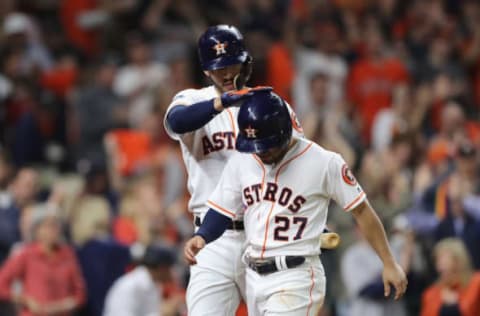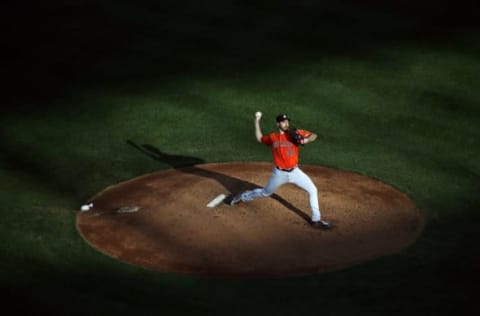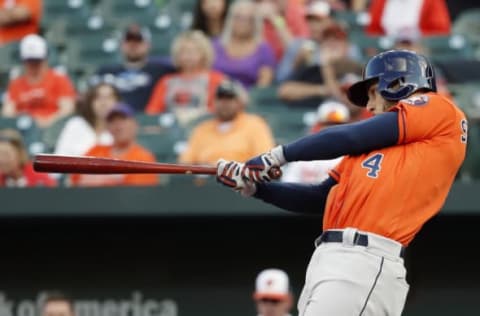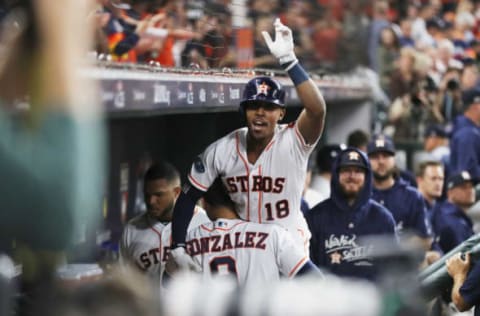Astros: Five things the team did well in 2018


Whenever a team sets a new franchise-best in wins during a single season, you can bet that they did some things well. Quite well, indeed.
Back in 1998, the Astros won a then-franchise record 102 games. It would take 20 years and over 3,000 regular season games before another Houston team would top that win total.
To win 103 games in a single season, a lot of things have to go right. Terrific pitching is usually required along with timely hitting. The right breaks are needed. Lucky bounces, for example. How about miscues from the opposition? (Start at the 15:35 mark).
How about another miscue, but this time from a division rival?
As a word of advice for the other team, you may want to consider intentionally walking Alex Bregman with the game on the line? Just a suggestion.
Anyway, the Astros were fortunate to have some of the breaks go their way. Not all went right for Houston, though. Once again, these events occurred when playing a division opponent.
I’m still waiting for the conclusive evidence on that one for the overturned call at home plate. But I digress.
The Astros had plenty of breaks go their way. In addition, help from unexpected places. Seriously, there are some years where little goes according to plan in baseball. But the help did not go for naught as the Astros were able to hold off rivals like the A’s and Mariners just long enough. Despite a disappointing finale to the ALCS along with questionable calls, Houston witnessed a high quality baseball once again.
In what specific areas did the Astros perform well? Let’s delve deeper into the subject material.

Superb starting pitching
In 2018, there wasn’t a better starting rotation in the regular season than the one employed by the Astros. If you disagree, well, I’m not sorry. If your starting rotation can boast the best ERA (3.16), FIP (3.28), and strikeout rate (28.2%) while finishing second in innings pitched (955 1/3 IP), then you’ve earned bragging rights.
The Astros’ 2018 starting rotation may go down as the best in club history. Justin Verlander, Gerrit Cole, Dallas Keuchel, Charlie Morton, and Lance McCullers were absolutely terrific as a group most of the season. Three of these pitchers, Verlander, Cole, and Morton, finished with 200-plus strikeouts. Even when McCullers and Morton missed some starts from August onwards, Framber Valdez and Josh James filled in admirably.
As a staff, the Astros led baseball with 1,101 strikeouts while limiting opposing lineups to 335 earned runs, the third-lowest total in the majors. In addition to the earned runs, Houston also limited hitters to only 100 home runs. Incidentally, the staff finished 15th in walks allowed at 298.
In terms of win probability, it should come as no surprise that the Astros finished second in RE24 (123.58) and first in Win Probability Added (13.40). This staff stepped up time and time again, especially when the offense wasn’t performing how they ought to throughout the season. If it wasn’t for the starting rotation, I am not sure if the Astros could’ve topped the A’s this year in the AL West.
The staff will be in a state of flux, though, as both Keuchel and Morton are free-agents this winter. While Keuchel’s demands could eventually lead him to another franchise, it isn’t a guarantee that Morton will continue to play. McCullers could find himself on the mend if surgery is required on his right elbow. Right now, I recommend that you’d bask in the memory of this starting rotation. We may not see another like this one any time soon.

Limited the strikeouts
Remember when there was a concern about the number of strikeouts the Astros were accumulating early in the season? Let’s just say that the worrying didn’t last long. All in all, Houston finished with the second-lowest total strikeout total (1,197) and second-lowest strikeout rate (19.5%). Only their ALDS opponent, the Indians, finished lower in both categories.
When the Astros’ historic offense in 2017 was all said and done, the lack of strikeouts was viewed as a key byproduct of their approach. The change in approach is something fun to watch in recent seasons, despite a slight uptick in 2018.
Team strikeout rate
2015: 22.9% (2nd)
2016: 23.4% (4th)
2017: 17.3% (30th)
2018: 19.5% (29th)
Will less strikeouts from year to the next the only way to improve an offense? Nope. In fact, it is not a given that an offense would actually improve by striking out less. But the Astros continued to do something well that was a key change to the formula from years past. Gone are the days, at least temporarily, of high strikeout hitters like Chris Carter and Colby Rasmus.
As most of the position players are returning in 2019, the Astros ability to limit strikeouts may come in handy next season. In this era of the three true outcomes (walk, strikeout, or home run), the ability to get the ball in play could help quite a bit in the postseason.

Help from unexpected places
The test for a quality franchise isn’t exclusively the performance of its stars, but sometimes the help received from unexpected places. Let’s face it as every team is going to rely upon its depth sooner or later. The Astros were no different as Tony Kemp, Tyler White, Framber Valdez, Josh James, and others made a notable impact on the roster. Here is how the four that I had previously mentioned and how they performed by Wins Above Replacement (FanGraphs and Baseball Reference).
Tony Kemp: 0.9 fWAR/1.0 bWAR
Tyler White: 1.5 fWAR/1.6 bWAR
Framber Valdez: 0.1 fWAR/1.1 bWAR
Josh James: 0.4 fWAR/0.7 bWAR
Kemp and White filled in admirably during the regular season and postseason for Houston. Due to the injuries to Jose Altuve, Carlos Correa, and George Springer, the duo provided a spark in a lineup that needed it. If you’d require further proof, check out the Astros’ lineup during late July into early August. Trust me, their contributions were needed.
Thanks to McCullers and Morton suddenly finding themselves on the shelf with various arm ailments, James and Valdez were called upon to start. Both players were able to pitch well late in the season, and provided Houston a chance to regain its health. James, in the postseason, demonstrated what he is capable of when given an opportunity.
Like the Cardinals, the Astros long-term hope hinges on the quality depth produced by the minor league system. Thanks to a wave of reinforcements, Houston was able to hold off the A’s and Mariners for the AL West title. Without these guys, I am not sure that a division title would’ve happened.

Making contact all season long
Let’s cut to the chase: The Astros were one of the best teams in 2018 about generating contact. Here are the top three contact rates, by team, in baseball this year:
Indians – 80.6%
Astros – 79.9%
Red Sox – 79.3%
Unsurprisingly, Houston also finished with the highest contact rate outside the strike zone (67.7%) and the third-highest contact rate inside the strike zone (87.2%). The Astros also finished with the lowest strikeout rate (18.9%) and tied with the Indians for lowest swinging strike rate (8.9%) in baseball. When there was a batter with a H-star logo on top of the batting helmet, odds are that generating contact would be the approach. And it worked quite well for Houston as the team won 103 games.
Isn’t it ironic how the 2015-16 Astros were known for its power and high strikeout approach? Fast forward to the next two seasons and now we’ve seen a near 180-degree reversal. Personnel changes were a key factor in the change, but improvement from its core was also key. Let’s use Alex Bregman’s contact rate since his debut as an example:
2016: 74.7%
2017: 85.7%
2018: 88.5%
Yes, Bregman’s debut season in 2016 doesn’t have a large sample size, but it is clear to see how he has improved during the past two seasons. It is one reason why the former second overall pick transformed himself into one of the best third baseman in baseball.
Here is a better example in George Springer:
2015: 69.5%
2016: 73.9%
2017: 78.7%
2018: 78.2%
But the opposite can be true for improvement to take place. Here’s Jose Altuve’s contact rates from 2015 through 2018:
2015: 89.8%
2016: 86.1%
2017: 84.9%
2018: 83.6%
The Astros made a decision to feature a more contact-oriented lineup, completely intentional or not. Their players have made changes to their approach. If anything else, Houston was one of the best teams with adjustments.
Lots of shifting
Shifting, for better or worse, has generated plenty of dialogue in baseball about player positioning. Some are all for it, some are against it, and a few are not quite sure what to make of it. Regardless of your position (pun intended), the Astros led the way in shifting this year.
Total shifts by plate appearances in 2018
Astros – 2,195
Rays – 1,781
Twins – 1,734
Only the Rays (24.8%) and Twins (22.1%) shifted more against right-handed hitters than the Astros (21.2%). However, Houston took the cake with shifting a league-high 59.7% against left-handed hitters. Only the Yankees at 52.6% shifted more than 50% against left-handed hitters. For context, the league average shift rate against right-handed hitters was only 8.9% and 29.6% against left-handed hitters. Houston’s front office led by Jeff Luhnow is not afraid to push the boundaries.
The Astros were particularly well known for employing dramatic shifts against hitters like the Rangers’ Joey Gallo in 2018.
I am curious to see how much teams like the Astros shift in the coming years. Russell Carleton of Baseball Prospectus, and author of The Shift, warned that the shift might be “a mirage” here. Warning that there is quite a bit of math in his article, yet definitely well worth the read. Also, Carleton doesn’t advocate for the end of the shift, but he does present data which indicates that the shift isn’t exactly working. Again, check it out if you have time.
Next. Areas of concern for the Astros heading into the offseason. dark
For Houston, though, the shift was a point of emphasis this past season. They were on the leading edge of the movement. If you were to classify a job well done by the number of times you did it, then the Astros shifted well in 2018. But Houston held teams to a .294 wOBA in all shift situations, which is the 17th-best mark in baseball. Like I mentioned in the previous paragraph, I am curious to see how the Astros shift in the coming years.